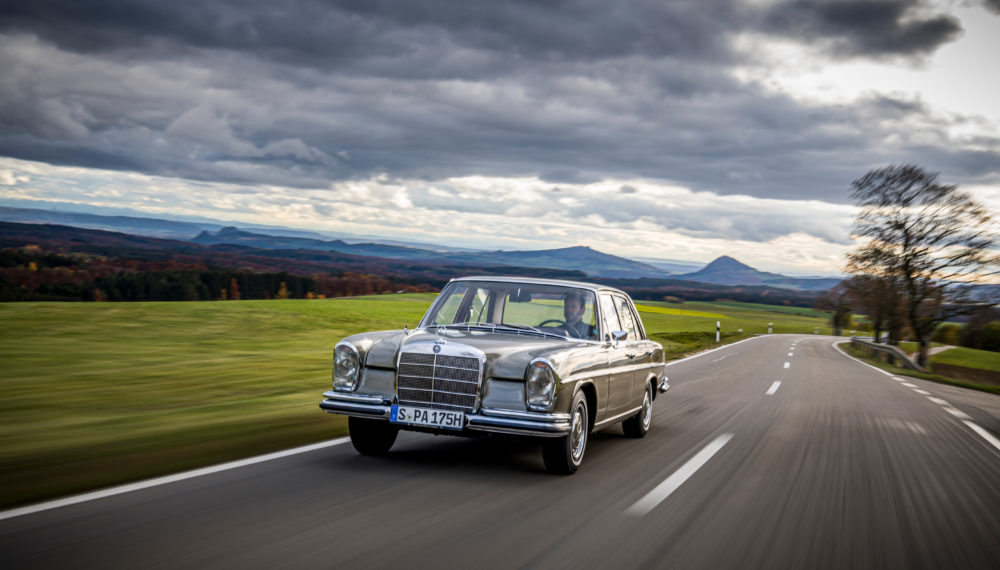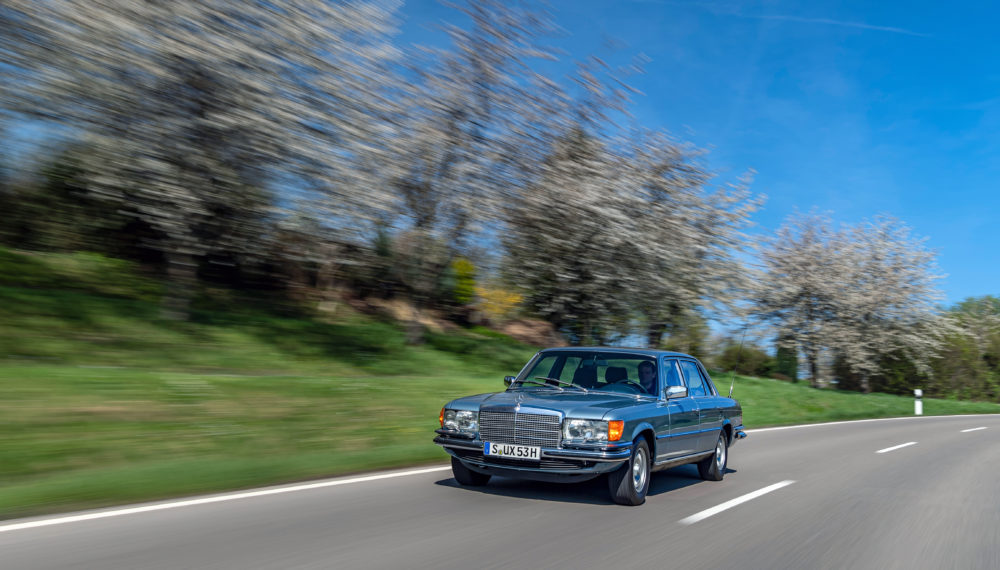In 1981 Mercedes-Benz was the world’s first automobile manufacturer to present the airbag and belt tensioner as restraint systems to the public in a series-production car. These two milestones in passive safety were premiered in a W 126-series S-Class Saloon at the 1981 Geneva Motor Show. At Mercedes-Benz, this began the introduction of the modern airbag as a passive safety feature into the entire passenger car range, with the airbag and belt tensioner already becoming available as optional extras for all Mercedes-Benz cars in 1982. By 1992 a driver airbag was standard equipment in all Mercedes-Benz models, followed by a front passenger airbag as a standard safety feature in 1994, and afterwards Mercedes-Benz realised numerous other applications for its airbag technology.
Mercedes-Benz research on the airbag began in 1966, with practical trials starting in 1967. This was one of the company’s responses to the large increase in accident figures in the 1960s. In previous years Mercedes-Benz had already set standards in passive safety with innovations such as the safety bodyshell with a rigid passenger cell and crumple-zones at the front and rear. The airbag also became a decisive component in the brand’s continuous commitment to improved vehicle safety.
Research on the new restraint system was given even more impetus by plans in the United States of America to prescribe an automatic occupant protection system for all cars from 1969. Airbags were seen as a very promising technology with which the new legal requirements could be met. The principle of the airbag as protection for the driver and front passenger during an accident was already patented in the 1950s. The principal pioneers were the German Walter Linderer (Patent DE 896312 of 6 October 1951) and the American John W. Hedrik (Patent US 2649311 of 18 August 1953).
For more than ten years the “inflatable container in a folded state, which automatically inflates in the event of danger” (Linderer’s description of his invention in the patent application) now became an object of research with the aim of bringing it to series production maturity. The work of Mercedes-Benz engineers and their colleagues working for other automobile manufacturers and suppliers during the 1960s was initially basic research. Equipment with which the idea from the 1950s might be realised did not exist at the time.
Particularly the necessary sensor systems and gas generation continued to present major challenges to the developers. When American manufacturers began to deliver their first test fleets with compressed-air operated airbags, these restraint systems – which were conceived as an alternative to seat belts – sometimes led to serious injuries and in a few cases even fatalities. For this reason the general introduction of airbags in all passenger cars in North America, which had initially been urgently demanded, was repeatedly postponed.
Meanwhile Mercedes-Benz in Stuttgart was working on an airbag technology that was different in many respects. The safety specialists at Mercedes-Benz opted for a gas generation system based on chemical propellants rather than pressurised gas. Neither was the airbag developed as a stand-alone restraint system, but instead as a feature working together with the seat belt. This was expressed in the internationally used abbreviation SRS, which stands for “Supplemental Restraint System”. As early as 1970, Mercedes-Benz commented on its accident research findings in a letter to a German motoring magazine: “The effectiveness of the airbag system in combination with a lap-belt and head restraint during a frontal or rear-end collision can be described as good.”
From 1967 onward, practical testing of gas generation systems continued with chemicals similar to the solid fuels used for rockets. In contrast to gas-filled cartridges, this form of propellant proved to be a reliable and rapid gas generator. The resulting gas mixture mainly consisted of nitrogen, inflating the airbag made from special woven material within fractions of a second so that it could gently cushion passengers as they were thrown forward by the impact in an accident.
The central findings from these early trials were formulated in patent no. DE 2152902 C 2, which the then Daimler-Benz AG filed on 23 October, 1971. This patent application was the key document for all subsequent airbag development at Mercedes-Benz. It already contained the operating principle of the new technology as it was to be implemented in series production ten years later: sensors register the particularly severe deceleration common to collisions and activate the airbag mechanism. This ignites a propellant charge (at the time consisting of sodium azide = hydrazoic acid salt, potassium nitrate = nitric acid salt and sand), which explodes to form mainly gaseous nitrogen and a little water and oxygen.
As the tests showed, the airbag really only achieved its full effectiveness in combination with the seat belt. And it was the seat belt that played a decisive role in the second innovation presented by Mercedes-Benz in Geneva in 1981 – the belt tensioner. Initially this was developed and made available for the front seat passenger, but by 1984 the belt tensioner already became standard equipment for the front seats of all Mercedes-Benz passenger cars. Like the airbag, the belt tensioner is activated by pyrotechnics: during an accident, the control unit fires a propellant charge which tightens the seat’s three-point inertia-reel seat belt within milliseconds. This eliminates the slack between the occupants torso and the seat belt, the occupant is held firmly in the seat by the belt and the forces generated by the kinetic energy of the collision are immediately transferred to the belt. From 1995 onward, belt tensioners were combined with belt force limiters in all models to adapt the action of the restraint system to individual requirements. In 2002 an electronic belt tensioner was added to the pyrotechnical belt tensioner with the introduction of the preventive occupant protection system PRE-SAFE®.
The evolution undergone by the airbag was even more extensive: the driver airbag became standard equipment in all Mercedes-Benz passenger cars in 1992, and in 1994 it was followed by the front passenger airbag. As airbag modules became smaller and smaller thanks to the work of the engineers, it was possible to incorporate them in other areas of a vehicle to achieve comprehensive protection in the event of a side impact as well. In 1993 Mercedes-Benz presented a sidebag as a study, and in 1995 the sidebag became available as an optional extra, initially in the E-Class. The windowbag became standard equipment from 1998, at first in the S-Class. In 2001 the head/thorax sidebag was introduced for the roadsters in the Mercedes-Benz SL-Class. Adaptive airbags form part of the safety philosophy PRO-SAFE™ in the W 221-series S-Class. And in 2010 the experimental safety vehicle ESF 2009 from Mercedes-Benz showed a totally new form of airbag: the Braking Bag is accommodated in the vehicle’s underbody, and is activated just before a collision. It has a friction coating to support the vehicle against the road surface, providing additional deceleration prior to the impact.
Production of the first S-Class models with an airbag and belt tensioner began at the Sindelfingen plant in 1980; after its presentation in Geneva, the 126 series went on sale with the new feature in July 1981. The combination of a driver airbag and front passenger belt tensioner was initially restricted to the S-Class, and was priced at DM 1525.50 as an optional extra for the Saloon and Coupé. By way of comparison, the flagship model in the S-Class at the time, the model 500 SEL, cost DM 61,505.90 in July 1981. In the second half of 1981 the Coupé with the same engine, the C 126-series model 500 SEC, was to be had for DM 73,902.
In the first year after introduction of the airbag and belt tensioner, 2636 S-Class customers already decided in favour of the new safety feature. The airbag was on its way to resounding success. More than twelve million Mercedes-Benz vehicles were equipped with the new airbag technology in the first 25 years after its presentation, with other car brands immediately following suit. The optional extra of 1981 became a standard restraint system that acts together with other passive safety features and has since saved thousands of lives in accidents.



















